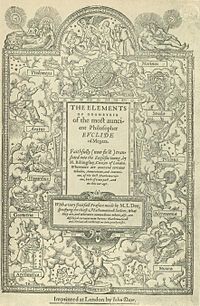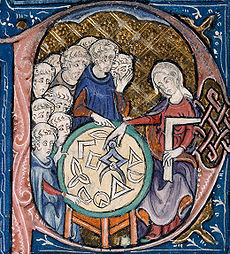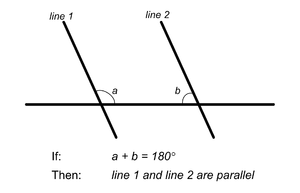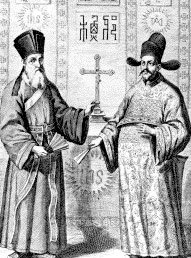
Euclid's Elements
About this schools Wikipedia selection
SOS Children offer a complete download of this selection for schools for use on schools intranets. SOS mothers each look after a a family of sponsored children.
Euclid's Elements (Greek: Στοιχεῖα) is a mathematical and geometric treatise consisting of 13 books written by the Greek mathematician Euclid in Alexandria circa 300 BC. It comprises a collection of definitions, postulates ( axioms), propositions (theorems and constructions), and mathematical proofs of the propositions. The thirteen books cover Euclidean geometry and the ancient Greek version of elementary number theory. With the exception of Autolycus' On the Moving Sphere, the Elements is one of the oldest extant Greek mathematical treatises and it is the oldest extant axiomatic deductive treatment of mathematics. It has proven instrumental in the development of logic and modern science.
Euclid's Elements is the most successful and influential textbook ever written. Being first set in type in Venice in 1482, it is one of the very earliest mathematical works to be printed after the invention of the printing press and is second only to the Bible in the number of editions published, with the number reaching well over one thousand. It was used as the basic text on geometry throughout the Western world for about 2,000 years. For centuries, when the quadrivium was included in the curriculum of all university students, knowledge of at least part of Euclid's Elements was required of all students. Not until the 20th century, by which time its content was universally taught through school books, did it cease to be considered something all educated people had read.
History
Euclid was a Greek mathematician who wrote Elements in Alexandria during the Hellenistic period (around 300 BC). Scholars believe that the Elements is largely a collection of theorems proved by other mathematicians as well as containing some original work. Proclus, a Greek mathematician who lived several centuries after Euclid, writes in his commentary of the Elements: "Euclid, who put together the Elements, collecting many of Eudoxus' theorems, perfecting many of Theaetetus', and also bringing to irrefragable demonstration the things which were only somewhat loosely proved by his predecessors".
Although known to, for instance, Cicero, there is no extant record of the text having been translated into Latin prior to Boethius in the fifth or sixth century. The Arabs received the Elements from the Byzantines in approximately 760; this version, by a pupil of Euclid called Proclo, was translated into Arabic under Harun al Rashid circa 800 AD. The first printed edition appeared in 1482 (based on Giovanni Campano's 1260 edition), and since then it has been translated into many languages and published in about a thousand different editions. In 1570, John Dee provided a widely respected "Mathematical Preface", along with copious notes and supplementary material, to the first English edition by Henry Billingsley.
Copies of the Greek text still exist, some of which can be found in the Vatican Library and the Bodleian Library in Oxford. The manuscripts available are of variable quality, and invariably incomplete. By careful analysis of the translations and originals, hypotheses have been drawn about the contents of the original text (copies of which are no longer available).
Ancient texts which refer to the Elements itself and to other mathematical theories that were current at the time it was written are also important in this process. Such analyses are conducted by J. L. Heiberg and Sir Thomas Little Heath in their editions of the text.
Also of importance are the scholia, or annotations to the text. These additions, which often distinguished themselves from the main text (depending on the manuscript), gradually accumulated over time as opinions varied upon what was worthy of explanation or elucidation. Some of these are useful and add to the text, but many are not.
A difficult text
Although we now consider the Elements to be an elementary text on geometry, that was not always the case. It is said that King Ptolemy asked for a way in geometry that was shorter than the Elements. Euclid answered that "there is no royal road to geometry." More recently, Sir Thomas Little Heath wrote, in the introduction to the 1932 Everyman's Library Euclid Introduction
- "The simple truth is that it was not written for schoolboys or schoolgirls, but for the grown man who would have the necessary knowledge and judgment to appreciate the highly contentious matters which have to be grappled with in any attempt to set out the essentials of Euclidean geometry as a strictly logical system..." .
The first difficult passage of Book I is refered to as the pons asinorum, which is Latin for "Bridge of Asses" (traditionally, it is hard to get asses to cross a bridge).
Outline of the Elements
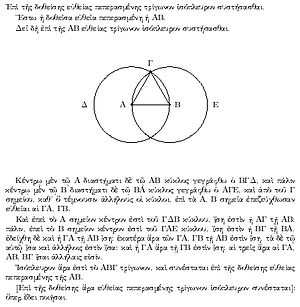
The Elements is still considered a masterpiece in the application of logic to mathematics. In historical context, it has proven enormously influential in many areas of science. Scientists Nicolaus Copernicus, Johannes Kepler, Galileo Galilei, and Sir Isaac Newton were all influenced by the Elements, and applied their knowledge of it to their work. Mathematicians and philosophers, such as Bertrand Russell, Alfred North Whitehead, and Baruch Spinoza, have attempted to create their own foundational "Elements" for their respective disciplines, by adopting the axiomatized deductive structures that Euclid's work introduced.
The success of the Elements is due primarily to its logical presentation of most of the mathematical knowledge available to Euclid. Much of the material is not original to him, although many of the proofs are his. However, Euclid's systematic development of his subject, from a small set of axioms to deep results, and the consistency of his approach throughout the Elements, encouraged its use as a textbook for about 2,000 years. The Elements still influences modern geometry books. Further, its logical axiomatic approach and rigorous proofs remain the cornerstone of mathematics.
Although Elements is primarily a geometric work, it also includes results that today would be classified as number theory. Euclid probably chose to describe results in number theory in terms of geometry because he couldn't develop a constructible approach to arithmetic. A construction used in any of Euclid's proofs required a proof that it is actually possible. This avoids the problems the Pythagoreans encountered with irrationals, since their fallacious proofs usually required a statement such as "Find the greatest common measure of ..."
First principles
Euclid's Book 1 begins with 23 definitions — such as point, line, and surface — followed by five postulates and five "common notions" (both of which are today called axioms). These are the foundation of all that follows.
Postulates:
- A straight line segment can be drawn by joining any two points.
- A straight line segment can be extended indefinitely in a straight line.
- Given a straight line segment, a circle can be drawn using the segment as radius and one endpoint as centre.
- All right angles are equal.
- If two lines are drawn which intersect a third in such a way that the sum of the inner angles on one side is less than two right angles, then the two lines inevitably must intersect each other on that side if extended far enough.
Common notions:
- Things which equal the same thing are equal to one another. ( Euclidean property of equality)
- If equals are added to equals, then the sums are equal. (Addition property of equality)
- If equals are subtracted from equals, then the remainders are equal. (Subtraction property of equality)
- Things which coincide with one another are equal to one another. ( Reflexive property of equality)
- The whole is greater than the part.
These basic principles reflect the interest of Euclid, along with his contemporary Greek and Hellenistic mathematicians, in constructive geometry. The first three postulates basically describe the constructions one can carry out with a compass and an unmarked straightedge. A marked ruler, used in neusis construction, is forbidden in Euclid construction, probably because Euclid could not prove that verging lines meet.
Parallel postulate
The last of Euclid's five postulates warrants special mention. The so-called parallel postulate always seemed less obvious than the others. Euclid himself used it only sparingly throughout the rest of the Elements. Many geometers suspected that it might be provable from the other postulates, but all attempts to do this failed.
By the mid-19th century, it was shown that no such proof exists, because one can construct non-Euclidean geometries where the parallel postulate is false, while the other postulates remain true. For this reason, mathematicians say that the parallel postulate is independent of the other postulates.
Two alternatives to the parallel postulate are possible in non-Euclidean geometries: either an infinite number of parallel lines can be drawn through a point not on a straight line in a hyperbolic geometry (also called Lobachevskian geometry), or none can in an elliptic geometry (also called Riemannian geometry). That other geometries could be logically consistent was one of the most important discoveries in mathematics, with vast implications for science and philosophy. Indeed, Albert Einstein's theory of general relativity shows that the real space in which we live is non-Euclidean.
Contents of the books
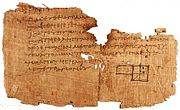
Books 1 through 4 deal with plane geometry:
- Book 1 contains the basic propositions of geometry: the Pythagorean theorem (Proposition 47), equality of angles and areas, parallelism, the sum of the angles in a triangle, and the three cases in which triangles are "equal" (have the same area).
- Book 2 is commonly called the "book of geometrical algebra," because the material it contains may easily be interpreted in terms of algebra.
- Book 3 deals with circles and their properties: inscribed angles, tangents, the power of a point.
- Book 4 is concerned with inscribing and circumscribing triangles and regular polygons.
Books 5 through 10 introduce ratios and proportions:
- Book 5 is a treatise on proportions of magnitudes.
- Book 6 applies proportions to geometry: Thales' theorem, similar figures.
- Book 7 deals strictly with elementary number theory: divisibility, prime numbers, greatest common divisor, least common multiple.
- Book 8 deals with proportions in number theory and geometric sequences.
- Book 9 applies the results of the preceding two books: the infinitude of prime numbers, the sum of a geometric series, perfect numbers.
- Book 10 attempts to classify incommensurable (in modern language, irrational) magnitudes by using the method of exhaustion, a precursor to integration.
Books 11 through 13 deal with spatial geometry:
- Book 11 generalizes the results of Books 1–6 to space: perpendicularity, parallelism, volumes of parallelepipeds.
- Book 12 calculates areas and volumes by using the method of exhaustion: cones, pyramids, cylinders, and the sphere.
- Book 13 generalizes Book 4 to space: golden section, the five regular Platonic solids inscribed in a sphere.
Criticism
Despite its universal acceptance and success, the Elements has been criticised as having insufficient proofs and definitions. For example, in the first construction of Book 1, Euclid used a premise that was neither postulated nor proved: that two circles with centers at the distance of their radius will intersect in two points. Later, in the fourth construction, he used the movement of triangles to prove that if two sides and their angles are equal, then they are congruent; however, he did not postulate or even define movement.
In the 19th century, non-Euclidean geometries attracted the attention of contemporary mathematicians. Leading mathematicians, including Richard Dedekind and David Hilbert, attempted to reformulate the axioms of the Elements, such as by adding an axiom of continuity and an axiom of congruence, to make Euclidean geometry more complete.
Mathematician and historian W. W. Rouse Ball put the criticisms in perspective, remarking that "the fact that for two thousand years [the Elements] was the usual text-book on the subject raises a strong presumption that it is not unsuitable for that purpose."
Apocrypha
It was not uncommon in ancient time to attribute to celebrated authors works that were not written by them. It is by these means that the apocryphal books XIV and XV of the Elements were sometimes included in the collection. The spurious Book XIV was likely written by Hypsicles on the basis of a treatise by Apollonius. The book continues Euclid's comparison of regular solids inscribed in spheres, with the chief result being that the ratio of the surfaces of the dodecahedron and icosahedron inscribed in the same sphere is the same as the ratio of their volumes, the ratio being  .
.
The spurious Book XV was likely written, at least in part, by Isidore of Miletus. This inferior book covers topics such as counting the number of edges and solid angles in the regular solids, and finding the measure of dihedral angles of faces that meet at an edge.
Editions
- 1460s, Regiomontanus (incomplete)
- 1533 editio princeps by Simon Grynäus
- 1572, Commandinus
- 1574, Christoph Clavius
Translations
- 1505, Zamberti (Latin)
- 1543, Venturino Ruffinelli (Italian)
- 1555, Johann Scheubel (German)
- 1562, Jacob Kündig (German)
- 1564, Pierre Forcadel de Beziers (French)
- 1570, John Day (English)
- 1576, Rodrigo de Zamorano (Spanish)
- 1594, Typografia Medicea (edition of the Arabic translation of Nasir al-Din al-Tusi)
- 1607, Matteo Ricci, Xu Guangqi (Chinese)
- 1660, Isaac Barrow (English)
- Present, Irineu Bicudo (Portuguese)(work in progress)
Currently in print
"Euclid's Elements - All thirteen books in one volume" Green Lion Press. ISBN 1-888009-18-7 Based on Heath's translation.
